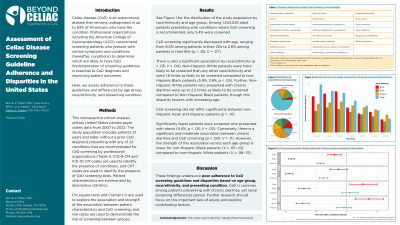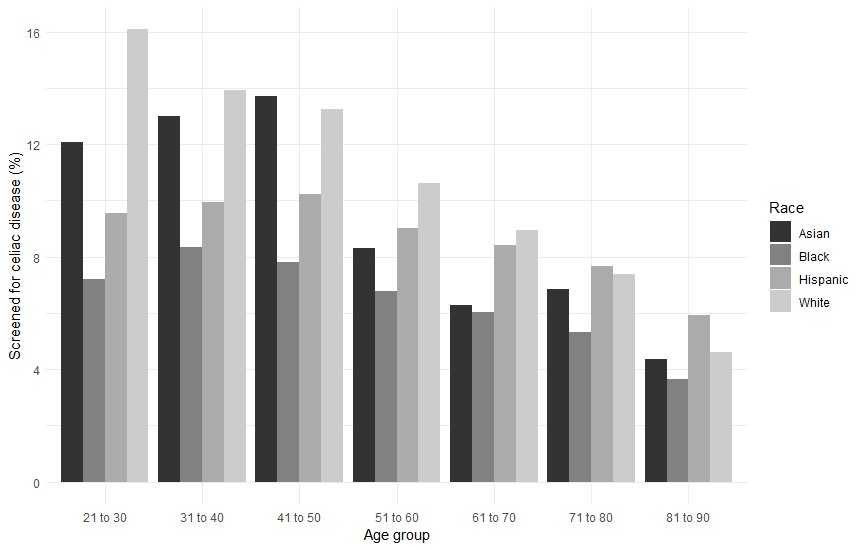Monday Poster Session
Category: Small Intestine
P3196 - Assessment of Celiac Disease Screening Guideline Adherence and Disparities in the United States
Monday, October 28, 2024
10:30 AM - 4:00 PM ET
Location: Exhibit Hall E

Has Audio

Debra G. Silberg, MD, PhD, FACG
Beyond Celiac
Ambler, MD
Presenting Author(s)
Erin B. P.. Miller, MPH, Kate Avery, MPH, Amy Ratner, BA, Alice Bast, BA, Debra G.. Silberg, MD, PhD, FACG
Beyond Celiac, Ambler, PA
Introduction: Celiac disease (CeD) is an autoimmune disease that remains undiagnosed in up to 83% of Americans who have the condition. Professional organizations, including the American College of Gastroenterology (ACG), recommend screening patients who present with certain symptoms and conditions (hereafter, conditions) to determine which are likely to have CeD. Implementation of screening guidelines is essential to CeD diagnosis and improving patient outcomes. Here, we assess adherence to these guidelines and differences by age group, race, and presenting condition.
Methods: This retrospective cohort analysis utilizes United States private payer claims data from 2007 to 2022. The study population includes patients 21 years and older without a prior CeD diagnosis presenting with any of 22 conditions that are recommended for CeD screening by professional organizations. ICD-9 or 10-CM and CeD serology CPT codes are used to identify presence of conditions and screening tests, respectively. Patient characteristics are summarized by descriptive statistics. Chi square tests and Cramér's V are used to explore the association and strength of the association between patient characteristics and CeD screening.
Results: Among 1,343,025 patients presenting with conditions where CeD screening is recommended, only 5.4% are screened. CeD screening significantly decreases with age, ranging from 8.0% among patients in their 20s to 2.6% among patients in their 80s (p < .003, V = .07). There are also significant differences by race, with more non-Hispanic White patients screened than expected (5.9%) and fewer patients screened who are non-Hispanic Black (3.8%), Hispanic (5.1%), or with unknown race data (4.2%) (p = .005, V = .04). In addition, significantly fewer patients are screened who present with ataxia (4.4%, p < .001, V = .02). Overall, there is a significant and moderate association between chronic diarrhea and CeD screening (p < .001, V = .11). However, the strength of this association across each age group is lower for non-Hispanic Black patients (V = .05.–10) compared to non-Hispanic White patients (V = .08.–15).
Discussion: These findings underscore poor adherence to CeD screening guidelines and disparities based on age group, race, and presenting condition. CeD is common among patients presenting with chronic diarrhea, yet racial screening differences persist. Further research should focus on this important lack of equity and explore contributing factors.

Disclosures:
Erin B. P.. Miller, MPH, Kate Avery, MPH, Amy Ratner, BA, Alice Bast, BA, Debra G.. Silberg, MD, PhD, FACG. P3196 - Assessment of Celiac Disease Screening Guideline Adherence and Disparities in the United States, ACG 2024 Annual Scientific Meeting Abstracts. Philadelphia, PA: American College of Gastroenterology.
Beyond Celiac, Ambler, PA
Introduction: Celiac disease (CeD) is an autoimmune disease that remains undiagnosed in up to 83% of Americans who have the condition. Professional organizations, including the American College of Gastroenterology (ACG), recommend screening patients who present with certain symptoms and conditions (hereafter, conditions) to determine which are likely to have CeD. Implementation of screening guidelines is essential to CeD diagnosis and improving patient outcomes. Here, we assess adherence to these guidelines and differences by age group, race, and presenting condition.
Methods: This retrospective cohort analysis utilizes United States private payer claims data from 2007 to 2022. The study population includes patients 21 years and older without a prior CeD diagnosis presenting with any of 22 conditions that are recommended for CeD screening by professional organizations. ICD-9 or 10-CM and CeD serology CPT codes are used to identify presence of conditions and screening tests, respectively. Patient characteristics are summarized by descriptive statistics. Chi square tests and Cramér's V are used to explore the association and strength of the association between patient characteristics and CeD screening.
Results: Among 1,343,025 patients presenting with conditions where CeD screening is recommended, only 5.4% are screened. CeD screening significantly decreases with age, ranging from 8.0% among patients in their 20s to 2.6% among patients in their 80s (p < .003, V = .07). There are also significant differences by race, with more non-Hispanic White patients screened than expected (5.9%) and fewer patients screened who are non-Hispanic Black (3.8%), Hispanic (5.1%), or with unknown race data (4.2%) (p = .005, V = .04). In addition, significantly fewer patients are screened who present with ataxia (4.4%, p < .001, V = .02). Overall, there is a significant and moderate association between chronic diarrhea and CeD screening (p < .001, V = .11). However, the strength of this association across each age group is lower for non-Hispanic Black patients (V = .05.–10) compared to non-Hispanic White patients (V = .08.–15).
Discussion: These findings underscore poor adherence to CeD screening guidelines and disparities based on age group, race, and presenting condition. CeD is common among patients presenting with chronic diarrhea, yet racial screening differences persist. Further research should focus on this important lack of equity and explore contributing factors.

Figure: Percentage of patients with chronic diarrhea screened for celiac disease by age group and race
Disclosures:
Erin Miller indicated no relevant financial relationships.
Kate Avery indicated no relevant financial relationships.
Amy Ratner indicated no relevant financial relationships.
Alice Bast indicated no relevant financial relationships.
Debra Silberg: Anokion – Advisor or Review Panel Member. Ellodi – Advisory Committee/Board Member. Intercept – Advisor or Review Panel Member. InveniAI – Consultant. Neurogastrx – Consultant.
Erin B. P.. Miller, MPH, Kate Avery, MPH, Amy Ratner, BA, Alice Bast, BA, Debra G.. Silberg, MD, PhD, FACG. P3196 - Assessment of Celiac Disease Screening Guideline Adherence and Disparities in the United States, ACG 2024 Annual Scientific Meeting Abstracts. Philadelphia, PA: American College of Gastroenterology.
